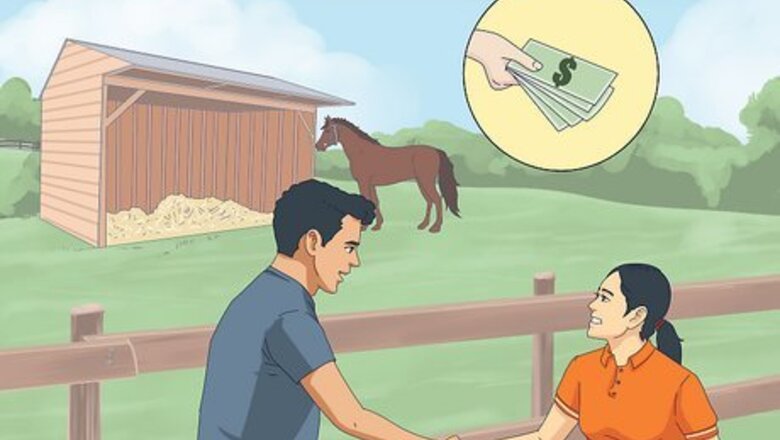
views
- Train your horse to change leads, or switch the leg that leads when they walk or run. This will help them avoid fatigue in races and training.
- Breeze your horse once per week. For a breeze, the horse is moving at a very quick pace—roughly 12 seconds per furlong.
- Enter local races to build up your horse's experience and credibility. Note that high-profile races will likely have a race fee.
Breaking in the Horse
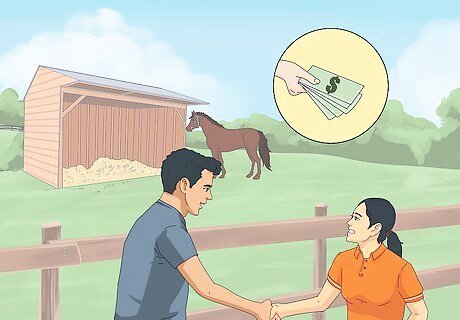
Lead train the horse so it’s comfortable being handled. Don’t try riding a young, untrained horse right off the bat—instead, use a long lead (or rein) to guide it around on foot. Focus on getting the horse to follow basic commands, like dropping its head and following along when you pull on the lead. It might take a bit of trial and error before your horse gets the hang of these basic commands, so be patient. To train a horse to drop its head, hold onto the end of the lead that’s close to the horse’s head. Tug downward on the lead very slowly and gently until the horse learns to drop its nose. Pull backwards on the lead gently and carefully to teach the horse to step back.

Teach the horse to lunge in a circular pen. Find a circular paddock or training area that’s large enough for your horse to move around. Stand in the middle of the paddock, holding the lead as though it’s a tether. Spin slowly while holding the lead to begin guiding the horse in a circle until it’s comfortable running on its own. You can use a lead with 2 long reins attached, if that’s easier. Tap the horse’s bottom lightly with a long riding crop to keep it moving. This process is also known as “lunging.” Since the horse will be running in a circular motion at a racetrack, it’s important to get them acclimated to running in a circle early on. Unless you live on a farm or near a stable, you’ll need to find another place to train your horse. Look online for training facilities near you, especially ones that focus on racing.

Place a roller around the horse’s girth to prepare them for a saddle. Measure around your horse’s stomach and purchase a roller, or tight pad, that wraps over its girth. Check that the roller is snug, but not too tight. Continue training in a circular paddock, using the roller to help your horse adjust. Before riding the horse, you want to help it get used to having pressure and weight on its back. The roller is a good stepping stone for this. You can purchase a roller at any shop that sells horse supplies.

Let the horse run with tack and a saddle on its back. Continue your training regimen in the circular paddock, encouraging the horse to run in a circular motion. Once your horse seems comfortable with the roller, switch it out with a saddle pad and saddle. Let the horse run with the new equipment on its back so it can continue adjusting. At this point, don’t try riding the horse yet.

Teach your horse to use a bit on a regular basis. Find a bit, or metal mouthpiece, that works well with your horse’s temperament and training level. You might find success with a traditional D-ring bit, which is flexible in the center. If your horse is more stubborn or ornery, you may want to use a ring bit or a Houghton bit, which provide you with a little more control. If you can’t decide which bit is best for your horse, talk to a training professional for help.
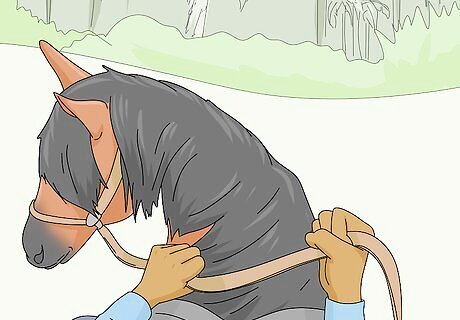
Use long reins so the horse can learn to turn right and left. While ground training your racehorse, slide a bridle and a long set of reins onto your horse’s head. Make sure that the reigns are around 10 feet (3.0 m) long, or long enough for you to stand a safe, comfortable distance behind the horse without getting kicked. Tug on either rein to teach your horse how to turn left and right. Continue training your horse in a circular pen or paddock. If your horse isn’t comfortable with the basics, it won’t be able to run and train properly at a track.

Adjust the horse to carrying human weight. Spend a day or 2 jumping around next to the horse without actually mounting it. Once the horse gets used to you, boost yourself up onto the saddle and straddle yourself horizontally across the horse’s back. After the horse seems acclimated to holding you up, switch to a normal riding position. These baby steps help your horse get used to handling a rider. If you try mounting the horse right away, you could spook it and end up getting bucked or otherwise injured. Different horses adjust at different rates. Don’t be discouraged if your horse doesn’t adjust well to riders right away.
Performing Basic Training

Ride the horse slowly in circles. Stay in the circular paddock and mount your horse. Instruct it to start moving, and make your way around the paddock at moderate pace. Always do this with another person around, just in case the horse misbehaves. Whenever you ride a horse, be sure to wear a helmet, boots, and proper work or riding clothes.

Teach the horse how to change leads so it doesn’t get tired out. Pull on either rein to make sure that your horse responds to basic steering commands. Ride your horse at a slow, steady pace and approach an inanimate object, like a fence. Lift your right leg to remove any pressure from 1 side of the horse’s flank, then place more pressure on the left leg. At this point, your horse should cooperate and change leads. Changing “leads” is a fancy term for switching which leg your horse “leads” with when it walks or runs. Since races are pretty high intensity, you don’t want your horse overworking the same legs. Try to approach the inanimate object from a 45-degree angle. This will make it easier to practice changing leads.

Take the horse to a larger enclosure so it can adjust to being ridden. Find a bigger paddock or enclosed area where your horse has more freedom to move around. This helps it to adjust to a larger area, like a racetrack. Keep your horse at a slow or moderate speed as you transition to this new area. Don’t move to a new enclosure until your horse understands basic commands, steering, and lead changing.

Train the horse to run in a larger, open area. Find a trail system or open field where your horse has a lot of room to roam. In this space, guide your horse to a canter and a gallop, which are the fastest speeds a horse can run at. Continue training and running in this open area until both you and your horse feel comfortable moving at fast speeds. You don’t want to head out to the racetrack until you and your horse are comfortable running.
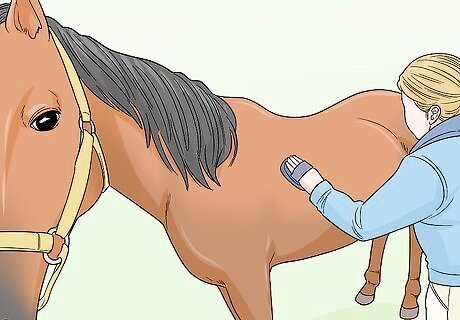
Cool down the horse after a day of training. Set your hose to the coldest setting and gently spray or sponge down the horse’s back, neck, and legs. Avoid using a cooling sheet, as this will cause your horse to overheat. Once you’ve rinsed down your horse, use a sweat scraper to get rid of any extra water.Tip: Always make sure that your horse has access to cool drinking water once you’re done training!

Wrap the horse’s legs to prevent any injury. Take a polo wrap or other bandage and loop it tautly around your horse’s ankles. While this isn’t a requirement, wrapping can help prevent your horse from getting unwanted scrapes on its ankles. Bandaging protects your horse during strenuous workouts, so wrapping every day can be a huge help. Just make sure to rewrap regularly, too. This can prevent skin irritation and circulation issues. You can buy wrap at any horse supply store.
Building Stamina and Speed
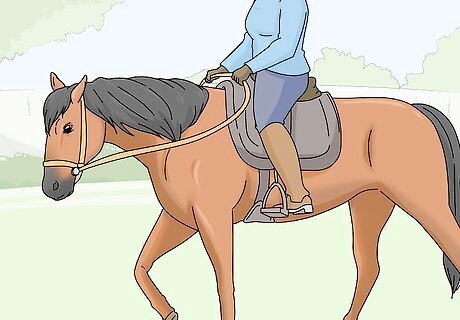
Do daily aerobic training to get your horse in shape. Ride your horse at a walking and trotting pace for several hours around the track to get it’s heart rate up. Use your fingers to check your horse’s pulse—during this training, you want your horse’s heart rate to be under 150 beats per minute. As your horse builds more stamina, practice walking, trotting, and cantering with your horse as you train. The amount of time you train depends on the stamina and skill of the horse. If your horse seems especially tired with a very high pulse, you may want to tone down your regimen. To check a horse’s pulse, put your pointer and middle finger beneath your horse’s lower jaw. Count its heartbeat for about 15 seconds, then multiply that number by 4 to get the total beats per minute.
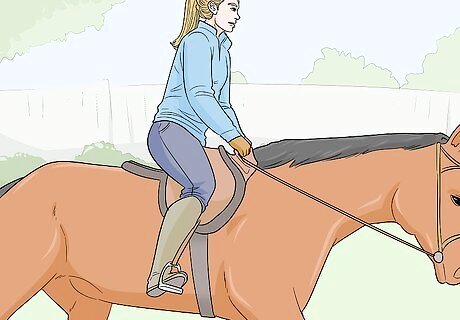
Practice riding your horse at different furlong speeds. Note that a furlong is 220 yd (200 m), which is a way to measure the distance of the race track. Experiment with different speeds, depending on the current skill and stamina of your horse. Start at a slow jogging pace, or “trot,” then work your way to a galloping pace, which is about 16-18 seconds for every furlong. When your horse develops a lot of stamina, try a “2-minute lick,” or when your horse runs 8 furlongs in 2 minutes. For instance, you could spend a few weeks exercising your horse at a trot or galloping pace, then work your way up to a 2-minute lick. If your horse is more in shape, you can focus your training more on galloping and 2-minute licks. Don’t overwork your horse! Training is a long, gradual process, and it will take time before your racing companion has the stamina it needs to race.
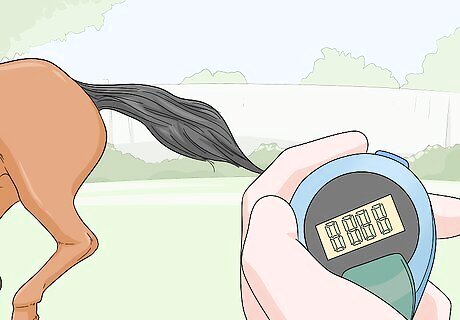
Perform a weekly work or breeze to raise the horse’s stamina. Tell a friend or colleague to wait at 1 section of the track with a stopwatch. Guide your horse around the track at a very fast pace, otherwise known as a “work” or a “breeze.” Have your colleague record the time of each lap, or whatever interval you’d like to measure. Note that a breeze pace is about 12 seconds per furlong. Some races are over 1 mile (1.6 km) long, so your horse needs to build up a lot of stamina to finish the race successfully. Works and breezes are a great stepping stone for this. You can do a weekly breeze to get an idea of how fast your horse is, and where you and the horse can still improve.
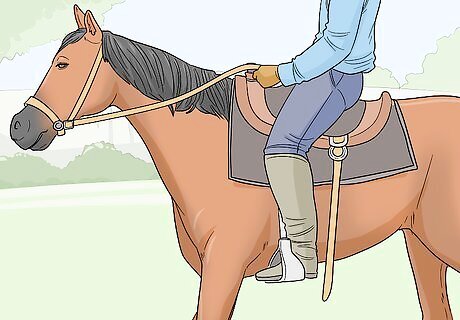
Increase your horse’s speed gradually. Don’t force your horse to an incredibly fast speed if you’re just starting out. Start by having your horse go 70-80% of their max speed, then slowly adding a furlong or 2 to the total distance they run. Continue increasing the total distance to match the length of the race. For instance, for the first few weeks, have your horse run 70-80% of their max speed for 1-2 furlongs. Over the next few weeks and months, gradually add another furlong or 2 to the workout. Never command your horse to run at top speed—this will tire out and strain your racing companion.
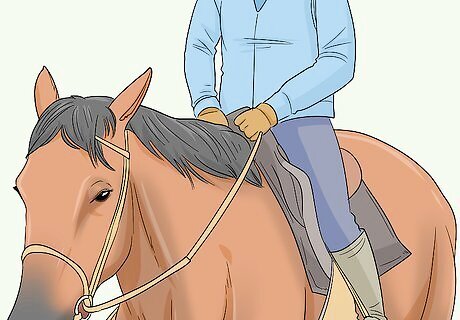
Walk or trot your horse for several minutes to cool down. Take your horse around the track at a slow, walking or trotting pace. Give your horse time to lower its heart rate so it doesn’t feel hot, sweaty, and out-of-breath at the end of the training day.
Transitioning to the Racetrack
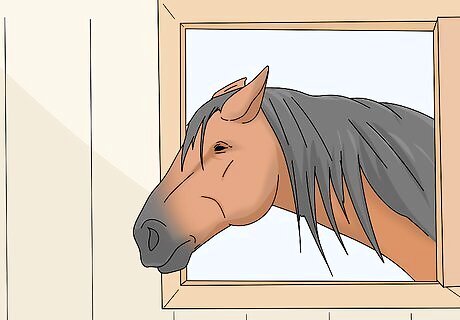
Introduce the horse to the stall enclosure at the racetrack. Visit an official racetrack, where your horse can get used to standing in a closed gate. Help your horse adjust to the sudden sounds and movements of the electric gate moving, which will occur every time a race begins. Many trainers will ride and practice with their horses at a racetrack.
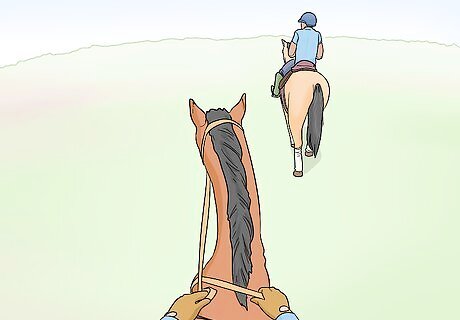
Train with others to help your horse adjust to a crowded environment. Visit the racetrack at a time when other trainers are around. Run next to other horses so your own horse can adjust to a crowded, loud environment. Additionally, your horse can get used to the dirt flying around, along with other sensory changes. If you don’t train with other horses, your horse could be overwhelmed when it goes to race for the first time.
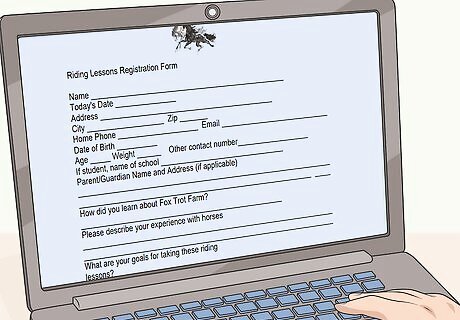
Register for races to start your racing career. Check online for races in your area. Note that high-scale races will likely have a registration fee or some other cost. Before joining high stakes races, see if there are any local competitions that you can join.

Publish your workout information online before joining a race. Reach out to the administration of the race you’ve registered for and see if they need your horse’s workout times. If so, take note of your horse’s breeze times, and how many furlongs your horse is currently breezing for. Compile this information into a digital spreadsheet, and send it along to the race administration. For instance, you can include the specific track, the training date, the course (e.g., dirt training), the distance (in furlongs), as well as the horse’s time. If your horse was racing against other horses during practice, note their rank in the spreadsheet as well.
Horse Racing Basics
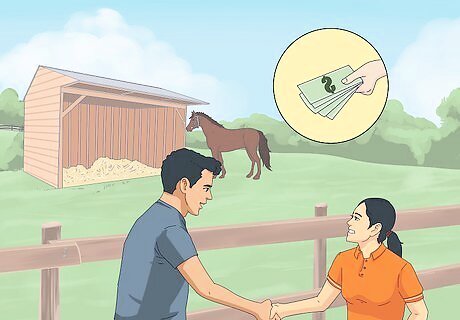
Set aside ~$10,000 for training (and ~$75,000 for the horse itself). While horse racing is an exciting, worthwhile hobby, it's not necessarily affordable. Between stable fees, training equipment, medical care, and food, costs add up. The price of buying a racehorse totally depends on its pedigree, because in the racing community, pedigree is thought to predict a horse's success. But can you make money through your racehorse? Yes, you can. Through successful races and breeding, the top earners make ~$100,000 per year.
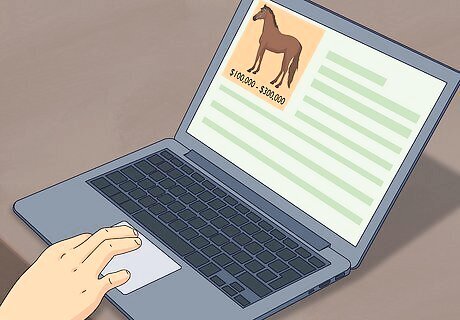
Research thoroughbred horses. Historically, these horses have defined the sport, so if you're looking to get started in racing, they're a great breed to look into. Thoroughbreds are actually a distinct breed of horse, which tend to be tall, lean, and very fast. They're actually marked with a lip tattoo and recorded in an official database, so if you have a thoroughbred horse, you'll know! Thoroughbreds will usually cost you more than the average racehorse, often between $100,000 and $300,000. On the whole, thoroughbreds follow the same training regiments as any other racehorse. So if you're interested in training this breed, start with the advice included above.
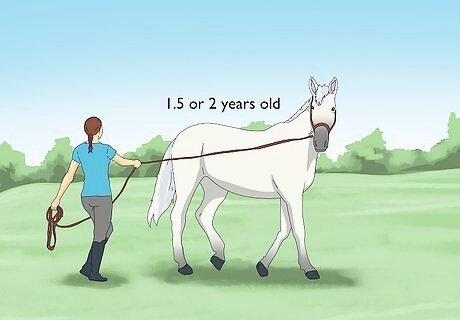
Start your horse's training when they're 1.5 or 2 years old. For the most part, horses start racing at the age of 2 and can continue racing until the age of 10. Though, they might retire early for a number of reasons, like injury. Studies have shown that early training can lead to more successful careers, better musculoskeletal health, and fewer injuries over time.
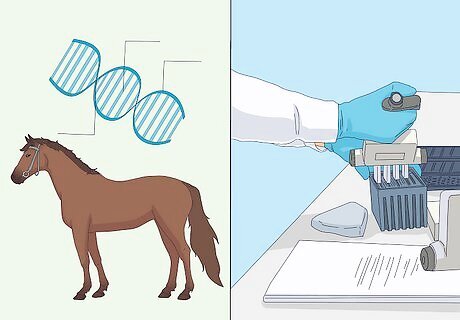
Look at your horse's genetics to determine their ideal distance. These days, genetic testing plays a huge role in horse racing. For roughly $1,250, racehorse owners can hire a professional testing center and discover whether their horse is best suited for shorter distances, longer distances, or both. This test can't predict top performers within each category, just an individual horse's best race distance.
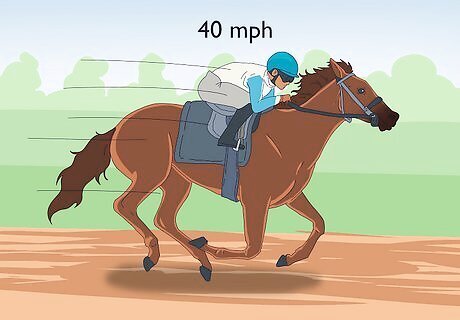
Train your racehorse to hit at least 40 mph to be competitive in races. So, how fast can race horses go exactly? Typically, the fastest horses in the world will hit speeds of roughly 55 mph. Though, speeds do change depending on the length of the race.




















Comments
0 comment